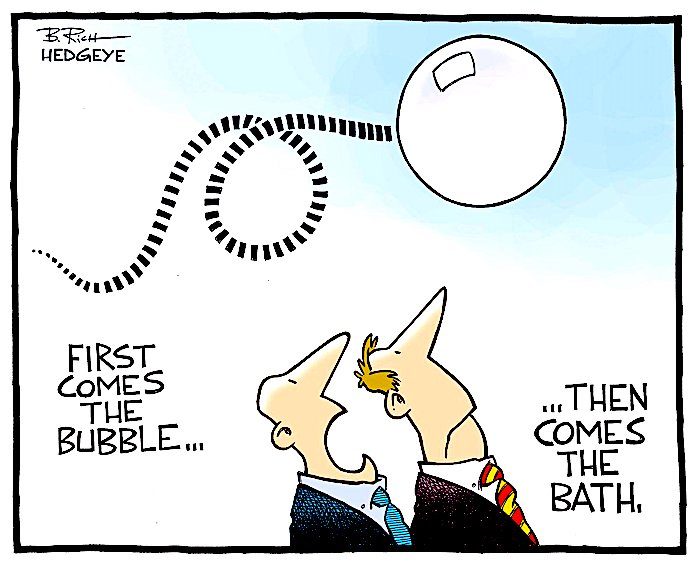
© B. Rich Hedgeye
When Nobel Laureate and
Irrational Exuberance author Robert Shiller says he sees bubbles in the financial markets — you'd better listen up. He literally wrote the book on stock market crashes and bubbles after all.
"I see bubbles everywhere," Shiller, economics professor at Yale University and author of just-published
Narrative Economics told investors gathered in Los Angeles Wednesday.
"There's no place to go. You just have to ride it out. You invest even though you expect the price to decline." Shiller famously predicted the 2000 stock market crash and the 2007 crash of the housing market.
The timing of Shiller's ominous warning comes at a scary time. This is the month of the 90th anniversary of
Black Monday. That day on Oct. 28, 1929, the Dow Jones Industrial Average fell 13%. That still stands as the second-worst drop in history and, combined with the pounding the stock market took in early days of the depression,
took 25 years for investors to recover from.Shiller sees bubbles in the stock market, bond market and the housing market. "You get ... in a situation where you know it's going to decline, but you still saved enough to hold you over; you have no choice."
Shiller Expects Lackluster Future U.S. Stock ReturnsShiller, who won the
Nobel Prize in economics in 2013, told
Investor's Business Daily he expects just 4.4% average annual returns in U.S. stocks over the next 30 years. That's a disappointing return expectation — less than half the market's long-term return and well
short of what pensions are calling for. The S&P 500's long-term return is 9.84%, says Index Fund Advisors.
The problem? The stock market is richly valued as prices have run up so much the past few years. The stock market is up 348% since the March 9, 2009 low, putting nearly $29 trillion into investors' portfolios.High valuations rob future gains, Shiller says. He says the so-called CAPE Ratio on U.S. stocks is at an elevated level of 29. The
CAPE Ratio, or Cyclically Adjusted Price-To-Earnings Ratio, looks at how much investors are paying for inflation-adjusted earnings averaged over a 10-year period. This indicator shows how expensive the market is, factoring out short-term distortions.
What's a high CAPE ratio, mean? "With a CAPE Ratio of 29 (currently), it's only happened a few times in history," Shiller says. "We got to the mid 30s in 1929. So that was a record." Markets subsequently crashed in 1929 and set off the Great Depression.
He adds, though, the CAPE ratio can still go higher
until an irrational exuberance bubble is deflated. "(The CAPE Ratio) went up to 45 in the year 2000 (prior to the 49% bear market decline from 2000 to 2002)," he said.
But the CAPE Ratio is slightly higher now than it was in 1987, before the market's biggest one-day drop of 23% on Oct. 19, 1987.What about more recently, ahead of the crushing 57% bear market from 2007 to 2009?
"In 2007 (the CAPE Ratio) was around this level, just before the other crash," he said. So "history shows that (the market's valuation) could go up to 45, just what it did 20 years ago, or ... lose half its value."
That's comforting.
Shiller: The 'Bond Market Boom Is Unsustainable'Shiller is as nervous about bonds as he is about U.S. stocks. Bonds continue to be one of the
hottest asset classes going as investors seek the
safety of income. The SPDR Portfolio Aggregate Bond ETF (SPAB) delivered a stock-like total return this year of 8.31%. That's more than twice its average annual return of 3.7% over the past 10 years. Investors are pouring money into bond ETFs, hoping to hide from stock-market volatility and get at least some return.
"It (the bond bubble) seems to be related to people not paying enough attention thinking through the simple logic ... this can't keep going and it's going to end badly," he said. "These things may sink at some point."Investors outside the U.S. are buying bonds with negative interest rates, simply betting they can sell to someone else when interest rates go even more negative. Holding the bonds until they mature locks in a negative return.
Shiller On Housing Bubble: "It's Just Like 2005 Again"Shiller says the housing market is in a bubble phase, not unlike 2005.
That was the point the housing bubble was inflated, but yet to go parabolic. "It's like 2005 again," Shiller said.
"San Francisco and L.A. are already slowing down." That's a "bad indicator," he said, as those markets have been going up for years.
Real-estate stocks are on fire, too.
The Real Estate Select Sector ETF (XLRE) is up nearly 29% just this year, blowing away the S&P 500's 20% gain. And that doesn't even include the Real Estate Select Sector's market-beating yield of 2.8%.
Real-estate stocks are just narrowly behind the Technology Select Sector SPDR ETF (XLK) as the top-performing sector of the year.Yet, given the housing bubble isn't as "excited as it was" in the early 2000s, Shiller has been reluctant to publicly call it a bubble until now. And he thinks enough people remember the 2000's housing bubble so they recall "home prices really do fall." We're not "as exuberant now, so I'm not sure it's a repeat performance," he said.
One Bright Spot: InternationalShiller says one spot in the world dodges such irrational exuberance:
Europe. Developed-world international stocks are largely left out of the global boom. He sees European stocks being almost a third cheaper than U.S. stocks.The Vanguard FTSE Developed Markets ETF (VEA) delivered just a 5.07% average annual return over the past 10 years. That's roughly half of international stocks' long-term expected return.
But investors are already pouring in. The Vanguard FTSE Developed Markets ETF is up 14% this year.
"I have higher expectations for Europe than the U.S.," he said.
Reader Comments